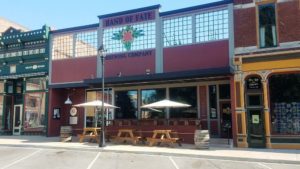The taproom at Hand of Fate Brewing is usually packed with people from outside Petersburg, Illinois, a small bedroom community of roughly 2,200 near the capital, Springfield.
Only a year old, the microbrewery and taproom has reversed the decline of this town, quite dramatically. Occupying a dead Dollar General discount store in the sparsely-populated downtown, they have become a community meeting place, encouraging nearby business to keep longer hours.
The brewery traffic also attracts new business: two boutiques have opened of to tap the mellow crowds’ pockets; a crowd that is drawn from the entire region. The 2017 “Drinkin’ with Lincoln” street festival was very successful.“Once Mike (Allison) got the brewery going,” says Neil Gurnsey, an assistant VP at the National Bank of Petersburg, “life was just injected into the square. If I go inside the bar and see that I know just 10 people out of 100, that’s great.”
As Hand of Fate shows, microbreweries are not just about beer: they’re increasingly serving as engines of economic development, and catalysts for cities and towns, especially in rural areas.
Margo Metzger, director of the North Carolina Craft Brewers Guild, has seen craft brewing explode in her state, generating $1.2 billion and 10,000 jobs in 2014. “I’ve spent my whole life here, and suddenly, you see breweries in forgotten Eastern North Carolina towns such as Rocky Mount and Tarboro,” she says. “It gives people a public house and a reason to want to live there. But more importantly, it makes people feel like they’re in a relevant place. It’s something new, beyond the old story of a fading town they’ve heard for decades. It’s a powerful, kickstarting force, a spark that I’ve seen time and again in this state.”
It’s not just rural towns, either; urban neighborhoods in dozens of struggling cities like Cleveland and Buffalo can trace their renaissance to microbreweries.
Note from Storm: Sometimes called “beer-oriented developmet”, the power of microbreweries to bring places back to life is being documented all across America. Their power actually derives from at least four factors:
- They are locally-owned, so the profits stay in the community;
- They are often started on small budgets, so they take over existing buildings, thus activating dead space;
- They serve as community centers, drawing locals not just frequently, but for longer periods of time than a dry cleaner or barber shop; and
- The draw from afar: beer lovers think nothing of driving an hour to try a new brewery, or visit a favorite.
Feature photo via Adobe Stock.


